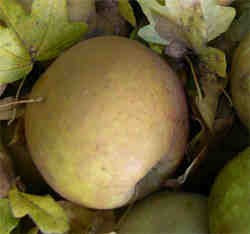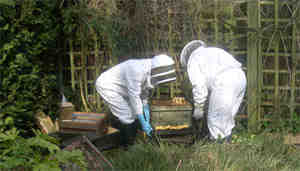Apple Chutney recipe
Posted by Fiona Nevile in Chutney and Pickles | 252 comments
Our apples make great chutney
I’m not surprised that the fruit that tempted Eve was an apple. It is such a useful fruit. From sweet apple puree to flagons of frothy cider, the apple plays a major role in our lives.
It always troubles me when I see apples left unpicked on trees. We’ve had a great cooking apple harvest this year. Danny and I have spent the morning picking apples from the old trees in our tiny orchard. We are going to make cider this year and have a go at apple wine. So we left a great pile of them on the garden table to soften in the frosts.
If you do this it’s easier to extract the juice. The ones that we pick from the tree are wrapped in newspaper and stored in cardboard boxes in the shed. The mice do nibble a few but the majority keep through the winter until we need them.
The windfalls don’t keep. Even if they look good they are bruised when they hit the ground. We have loads of windfalls, so we decided to branch out and add apple chutney to our range. As with our plum chutney we wanted a fruit rather than a vegetable taste.
This delicate chutney is the result.
| Cottage Smallholder Apple Chutney recipe |
- 1.5 k of cooking apples
- 500g of onions
- 500g of sultanas
- 750g Demerara sugar
- 500ml of white wine vinegar
- Zest and juice of two lemons
- I small chilli
- 1 tsp ground ginger
- 1 tsp ground allspice
- ½ tsp of cinnamon
- Pinch of ground cloves
- ½ tsp of Maldon sea salt
- 8 peppercorns
- 1 tbsp of mustard seed
- Wash, peel, core and chop the apples fine
- Peel and chop and mince the onions (if you don’t have a mincer chop them very fine)
- Put all ingredients into a large heavy bottomed saucepan and bring slowly to the boil. Stirring until the sugar is dissolved.
- Then simmer very gently, bubbles barely breaking the surface, until the chutney has thickened, stiring every now and then.
- It is ready when drawing a spoon across the surface leaves a definite track mark. This will take at least four hours.
- Pot into warm sterilised jars with plastic lined lids (how do I sterilise jars and lids? See Tips and Tricks below).
- Don’t use cellophane lids as the vinegar will evaporate through these and your chutney will dry up.
- Label when cold and store in a cool, dry place.
- Leave to mature for a month. The longer that you leave it to mature the better it will be!
Tips and Tricks
<strong>How do I get rid of tainted smells in pots?</strong>
If your cooking pot or container is tainted with the smell of the last resident (curry, tomato sauce etc). Sprinkle with a good tablespoon of bicarbonate of soda into it and add a good splosh of boiling water. Rub the solution over all surfaces and leave for two minutes. Rinse well in cold water.
<strong>How do I sterilise jars and lids?</strong>
The sterilising method that we use is simple. When the chutney is cooked, I quickly wash and rinse the jars and place them upside down in a cold oven. Set the temperature to 160c (140c fan assisted). When the oven has reached the right temperature I turn off the heat. The jars will stay warm for quite a while. I only use plastic lined metal lids for preserves as the all-metal lids can go rusty. I boil these for five minutes in water to sterilise them. If I use Le Parfait jars, I do the same with the rubber rings.
Leave a reply






Hi,
I am an experienced chef but I love your site. Since I retired I have gone back to trying to be self sufficient. I have a good garden and a large orchard and many old recipes. I am in my element.
hello I asked a question previously regarding the crunchy cucumber recipe, now I have bought the cucumbers I realise I should have thought about the container to hold them. I have large pickling pans, but I would need to chop the cues in half before I could soak them, would this be ok.?
I too made the apple chutney, it is good if a little too sweet, my tastes have changed somewhat since becoming diabetic. Next time I will adjust the the recipe a little.
Hi Kev
Go for it – but add a bit then taste and then add a bit more.
Excellent chutney. I have a second batch on under popular demand from friends and family. Do you think the chutney could take the heat of a few more chillis? Would love this with a little kick!
Hello KarenB
Yes Kate’s suggestion of baked potatoes with chutney is excellent. I have learnt so much in the three years that I’ve been writing this blog.
Thanks for your suggestion of a paginated index – it’s not boring at all. In fact most of our searches are not working properly atm for some unknown reason.
Hi Nicola w
You could cook the crabs separately and then pass them through a sieve/mouli/food mill and add the puree to the chutney. But then you would lose the texture. I can imagine anyone peeling crabs so I expect that they were used with the peels on.
I would like to use crab apples as others have but can anyone tell me if you have to peel and core them as they are very small. Look forward to trying the recipe.
Thanks
Hello Fiona,
Many thanks for your prompt helpful reply to my e-mails. I will be visiting your website again.
I have also been inspired by other people’s comments e.g. Kate(?)’s idea of mixing the inners of jacket potatoes with chutney, grated cheese and mayonnaise returning it to the skin and cooking until melted sounds brilliant.
Someone else suggested you could write a book – you have the makings of one if you insert a paginated index at the top of this site on topics and sub-topics covered here – perhaps that is too boring for words and you have better things to do.
I hope others’ comments means you are also a beneficiary of suggestions and ideas.
Hi Louise
Delighted that you found my recipe! Thanks for dropping by.
Hi Shar
I think that the chutney is very forgiving. I tried to design one with store cupboard ingredients.
Hi Scot
Sorry to miss your comment. It’s best to keep the apples and only make the chutney when you have enough jars. Some people go to ASDA and buy ultra cheap stuff in jars to get cheap jars.
Hello Splendid pickle lily
I wash them.
Hello KarenB
The apple chutney with balsamic vinegar sounds delicious.
I’ve never used malt vinegar as Danny cannot stand it so I can’t advise you on the problems or the life expectancy of your malt vinegar chutney.
Many apologies.
The only way to thicken chutney is to simmer it slowly so the vinegar evaporates. Of course thin chutney can be used in sauces and curries.
Regarding the medlar tree – I have never found one so cannot advise. I do know that they have to be belted (stored and softened) and I’ve heard that they make a tasty jelly.
Hello Fiona,
This is a quick “PS” to my previous message.
Yesterday I made apple chutney using the slow cooker and the same recipe, but with HALF the quantity of MALT vinegar. I have just tasted it – the consistency is fine and not so vinegary. A bit concerned it will be too “dry” when mature?
By the way there is a Medlar tree in our garden – tried to find something to do with Medlars, but they are hard and fiddly and end result not great
Any suggestions?
Best wishes,
Hello Fiona and Danny,
I was very pleased to come across your excellent website. Thank you for sharing it. I have already learnt a lot by reading other comments and your useful comments.
I made my first chutney by the crockpot/slow cooker method using Mary Norwak’s recipe from her book – “Crockpot Cooking”. The recipe was basic apple chutney with dates, sultanas and ginger requiring 500 ml (1 pint) of “vinegar” to 2.5 kg (5lb) of apples. I used BALSAMIC vinegar, cooked it overnight and the consistency was perfect. I kept it for several months and it was delicious.
This year I made an adapted spicy red tomato and apple recipe again by the slow cooker method, but with MALT vinegar. Malt vinegar contains more water which was not absorbed by slow cooking so I left the chutney in the crockpot for several more hours, but it was still runny. I lost patience and bottled it regardless. Could I have put gelatine in the mixture to thicken it before bottling it? If the chutney is still runny when opened can I thicken it in some way then. If not perhaps it could be used as a sauce or added to a curry dish. Any other suggestions?
The other day I made a basic green tomato chutney using Mary Norwak’s crockpot recipe using MALT vinegar. Again it was still runny after I had cooked it for hours. This time I strained the chutney before bottling and will used the excess vinegar in some way – e.g. salad dressings. Will the this “strained” chutney keep as long and be okay to eat. I have loads of malt vinegar which I am reluctant to throw away. Any suggestions about what to use up Malt vinegar for are welcome
Balsamic vinegar is more concentrated and better especially for slow cooking or less vinegar?
Apologies for this rather long message.
Warmest good wishes to you both.